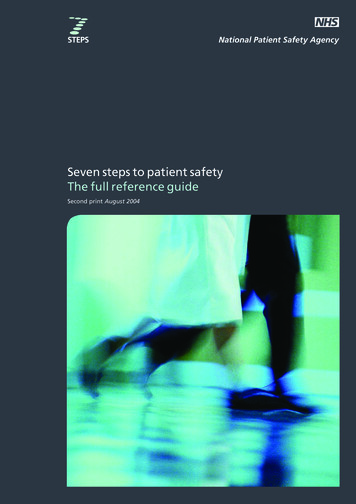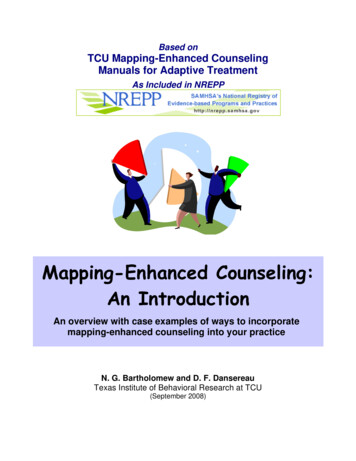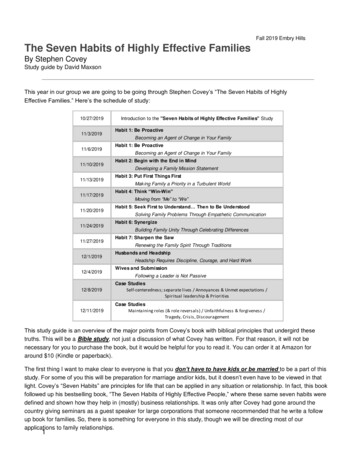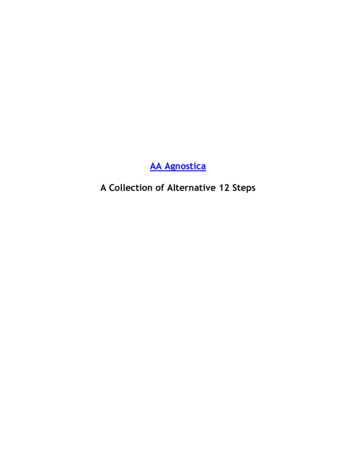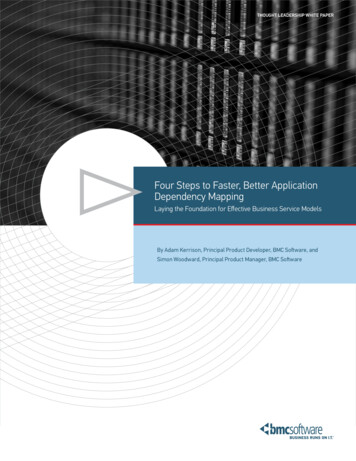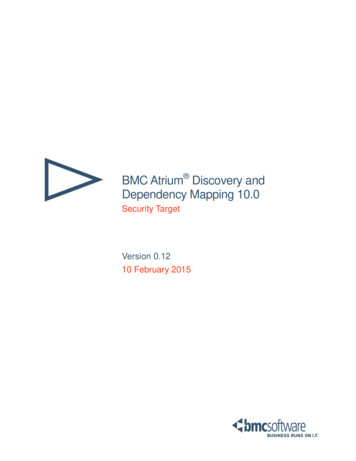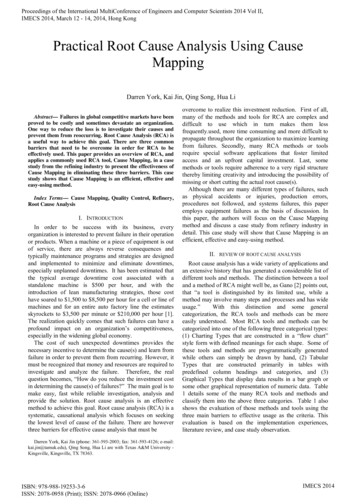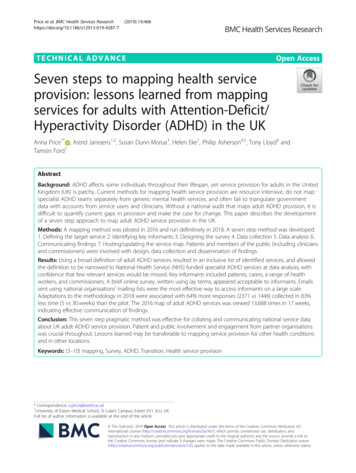
Transcription
Price et al. BMC Health Services 2019) 19:468TECHNICAL ADVANCEOpen AccessSeven steps to mapping health serviceprovision: lessons learned from mappingservices for adults with Attention-Deficit/Hyperactivity Disorder (ADHD) in the UKAnna Price1* , Astrid Janssens1,2, Susan Dunn-Morua3, Helen Eke1, Philip Asherson4,5, Tony Lloyd6 andTamsin Ford1AbstractBackground: ADHD affects some individuals throughout their lifespan, yet service provision for adults in the UnitedKingdom (UK) is patchy. Current methods for mapping health service provision are resource intensive, do not mapspecialist ADHD teams separately from generic mental health services, and often fail to triangulate governmentdata with accounts from service users and clinicians. Without a national audit that maps adult ADHD provision, it isdifficult to quantify current gaps in provision and make the case for change. This paper describes the developmentof a seven step approach to map adult ADHD service provision in the UK.Methods: A mapping method was piloted in 2016 and run definitively in 2018. A seven step method was developed:1. Defining the target service 2. Identifying key informants 3. Designing the survey 4. Data collection 5. Data analysis 6.Communicating findings 7. Hosting/updating the service map. Patients and members of the public (including cliniciansand commissioners) were involved with design, data collection and dissemination of findings.Results: Using a broad definition of adult ADHD services resulted in an inclusive list of identified services, and allowedthe definition to be narrowed to National Health Service (NHS) funded specialist ADHD services at data analysis, withconfidence that few relevant services would be missed. Key informants included patients, carers, a range of healthworkers, and commissioners. A brief online survey, written using lay terms, appeared acceptable to informants. Emailssent using national organisations’ mailing lists were the most effective way to access informants on a large scale.Adaptations to the methodology in 2018 were associated with 64% more responses (2371 vs 1446) collected in 83%less time (5 vs 30 weeks) than the pilot. The 2016 map of adult ADHD services was viewed 13,688 times in 17 weeks,indicating effective communication of findings.Conclusion: This seven step pragmatic method was effective for collating and communicating national service dataabout UK adult ADHD service provision. Patient and public involvement and engagement from partner organisationswas crucial throughout. Lessons learned may be transferable to mapping service provision for other health conditionsand in other locations.Keywords: (3–10) mapping, Survey, ADHD, Transition, Health service provision* Correspondence: a.price@exeter.ac.uk1University of Exeter Medical School, St Luke’s Campus, Exeter EX1 2LU, UKFull list of author information is available at the end of the article The Author(s). 2019 Open Access This article is distributed under the terms of the Creative Commons Attribution 4.0International License (http://creativecommons.org/licenses/by/4.0/), which permits unrestricted use, distribution, andreproduction in any medium, provided you give appropriate credit to the original author(s) and the source, provide a link tothe Creative Commons license, and indicate if changes were made. The Creative Commons Public Domain Dedication o/1.0/) applies to the data made available in this article, unless otherwise stated.
Price et al. BMC Health Services Research(2019) 19:468BackgroundAttention-deficit/hyperactivity disorder (ADHD) is aneurodevelopmental disorder that affects a significantproportion of individuals across their lifespan, for whichthere are effective, evidence based treatments [1]. Mentalhealth service provision in higher income countries isseparate for children and adults, and the transition oftenoccurs at a key developmental stage [2, 3]. Epidemiological studies show an estimated prevalence of ADHDof 5–6% in children, and 3–4% in adults [4–7]. Thenumber of young people with ADHD graduating fromchildren’s services has increased rapidly, because of arise in childhood prescription rates, [8] and studies havefound that many young people with ADHD are likely toneed continued care into adulthood [9–11]. Thereforeproviding a supported transition for this group in linewith clinical guidelines is important [12, 13]. However,provision for adults with ADHD remains relativelyscarce across the world [14] and is known to be patchyand difficult to access in the United Kingdom (UK) [15].Atlases of Health, which map international health service provision using government and expert sources, arewell-established tools designed to provide objective andreliable information on healthcare service provision [16–18]. The European Service Mapping Schedule [19] is asurvey instrument for the description and classificationof mental health services. It was adapted by Signorini etal. [20], and used to survey child psychiatry representatives on the characteristics of child and adolescent mental health services (CAMHS) across the European Union(EU). While valuable, these tools often fail to triangulategovernment and expert reports of service provision withthe experience of service users and clinicians in practice.The general focus also means that they may not capturecondition specific information.The Atlas of Variation series [21] uses routinely available data and consultation with clinical experts, to provide government reports (with maps, charts and timeseries data) on provision and patient outcomes for a selection of health topics [22]. However, to date, ADHDservices and outcomes have not been mapped. The information provided is also highly complex, difficult forlay readers to understand and does not include accountsfrom service users and clinicians. Independent regulatorssuch as the Care Quality Commission use inspectionmethodology including consultations with staff and service users and observing clinical practice to provide detailed reports on the state of care [23]. Findings arereported in a format that is accessible to a range ofstakeholders. However, this is a resource intensiveprocess, and most specialisms are not identified separately from community mental health, which makes it impossible to learn about adult ADHD service provisionfrom these reports [23]. Without a national audit aimedPage 2 of 12specifically at mapping adult ADHD provision, drawingon a range of stakeholder sources, it is difficult to quantify and address current gaps in healthcare and make thecase for appropriate change.In a recent survey of every National Health Service(NHS) mental health trust in England, senior health professionals were asked to provide information on transition protocols, pathways and commissioned services forADHD [24]. Over two thirds of NHS Trusts responded(68%). The survey was designed to be completed by a senior healthcare professional within the trust and it is unknown whether non-response from 17 trusts reflectsreluctance to report on gaps in services or other reasonsfor non-response such a lack of time or personnel. Lessthan half of the responding mental health trusts in England offered specialist provision for adults with ADHDand less than a third had specific commissioning arrangements for this group [24]. In a separate survey, allhealthcare professionals working in child and adulthealth services in the East Midlands region of England,were asked about transitional health services for youngpeople with ADHD [25]. The overwhelming majority ofrespondents reported a lack of provision [25]. Despite arelatively low response rate (19%), surveying all staff resulted in responses from a variety of professionals working with people with ADHD including psychiatrists,managers, nurses and paediatricians. This method, although more resource intensive and limited to asmaller geographic area, included perspectives of clinicians working daily with patients. It is possiblehowever, that they will not have daily experience ofservice provision in practice, while the pressures ofmanaging a resource strapped service may conflictwith straightforward reporting.Our recent systematic review of qualitative researchabout transition into adult ADHD services found that alack of available information about adult ADHD servicescreated difficulties in accessing treatment [26]. Peoplewith ADHD reported they did not know where to accesstreatment [27], while some clinicians reported difficultiesin finding an adult service to refer patients on to [28].This work indicates the importance of information aboutwhere services for ADHD are, what they offer and howto access them. Methods used to map ADHD servicesneed to collect data that is relevant and accessible to patients and clinicians as well as service providers andcommissioners. Different stakeholders are likely to havedifferent perspectives on what is as well as what needsto be available and it would be interesting to explore differences between provider’s reports on service availability and patient experiences of provision.To extend and expand the findings from previousresearch [20, 24, 25], we piloted and refined a multiinformant, multi-source methodology to map adult
Price et al. BMC Health Services Research(2019) 19:468ADHD provision in the UK. This paper describes theseven step approach that we developed. The methodsused are intended to meet current needs for nationalservice data specific to ADHD and to enable a comparison of differences in reported information by differentstakeholder groups.MethodsThe mapping methodology was piloted in 2016, followedby a definitive study in 2018: the mapping findings arereported in full elsewhere [29]. An iterative process oftrialling and reviewing methods (Fig. 1), led the development of the seven step mapping method described inthe current paper (Fig. 2).For a detailed seven step description of piloting workand adaptations involved in the development of thismethod see Additional file 1. For a summary of the stepsidentified, see Fig. 3.Patient and public involvementPeople with ADHD and their families, health workers,and commissioners were involved with design, data collection, and dissemination of research findings. An advisory group of parents of young people with mentalhealth difficulties, including ADHD, guided the iterativedevelopment of methods. Clinical and ADHD focussedorganisations supported distribution of the surveys andcommunication of findings.Defining target servicesServices to be included were broadly defined as “anymental health service for people with ADHD aged 18and above” located in the UK. In the 2018 study, noteswere added to clarify that this could include any “specialist doctor or team, mental health team, clinic, charityor support group that treats or supports adults withADHD” (see Additional files 2 and 3). Following dataFig. 1 Process of refining methodsPage 3 of 12collection, a second narrower definition was used to create a more focussed list of either: adult NHS specialist,private and charitable services, with a focus on treatingADHD or neurodevelopmental conditions (pilot); ordedicated adult ADHD services funded by the NHS(2018 study).SampleAs Table 1 illustrates, informants were purposively sampled from a range of key stakeholder groups (serviceusers, clinicians, and commissioners) via multiple methodologies and sampling frames.Data collectionData on services was collected using a brief survey. Surveys were either, tailored by respondent type and madeup of 9–15 questions (pilot) (see Additional file 2), orsuitable for all respondent types and made up of 5–9questions (2018 survey) (see Additional file 3). The survey collected basic demographic information, includingthe role or ‘identity’ of informants, with a drop down listof options including ‘other’ (see Additional file 2). Informants were asked to provide details of services theyknew about for adults with ADHD. In 2018 respondentswere asked to view a pre-populated list of services identified in the pilot, before being asked to provide detailsof any other services. They were also asked to confirmwhether they knew of someone who had used that service. Surveys were distributed using a variety of methods(see Table 1). In 2018, data collection was planned in advance with research partners (see Additional file 4), andinformants were given the opportunity to indicate additional roles, and asked to indicate whether they, or anyone they knew, had experience of using an identifiedservice for treatment/support of adult ADHD.
Price et al. BMC Health Services Research(2019) 19:468Page 4 of 12Fig. 2 Seven steps to map a serviceAnalysisService checkingDescriptive statistics summarised the numbers of andgeographic locations of respondents by informant group.An open source geographic information system, QGIS2.18 [30], was used to display the balance of responsesby UK region and stakeholder group.Details of identified services such as location, servicename, and the provider organisation were verifiedagainst online information (for example, via health provider or support group websites, or through service leaflets) by a second researcher. A list of services wascreated and categorised by type, provider organisationand location. A record was kept of which informantshad identified which service.Identified services were divided into two groups, withgroup one including all identified services, while grouptwo was restricted to either: specialist ADHD services,including adult NHS specialist, private and charitableservices with a focus on treating ADHD; or neurodevelopmental conditions (pilot); or dedicated adult ADHDservices, funded by the NHS (2018 survey).For adult NHS specialist services, details of the treatment and support provided was checked via a briefquestionnaire completed by the relevant health provider:phone or email contact (pilot); or via freedom ofData cleaningRaw data on services provided by informants, wereuploaded into Excel and matched against existing online information by the lead researcher, using searchterms derived from the informant’s description, theirgeographic location, and other terms relevant tosearch such as “ADHD, neurodevelopmental, andhealth service”. Where service details could not bematched against online data, they were independentlychecked. Unmatched service details were checked aminimum of three times before being categorised asunidentifiable.Fig. 3 Steps identified in running a mapping study
Price et al. BMC Health Services Research(2019) 19:468Page 5 of 12Table 1 Mapping study sampleNon-probabilisticsampling frameSurvey methodData collection formatStakeholders surveyedTotal populationSurvey of NHS commissioningorganisations Emails sent to NHS England commissionersa FOI requests sent to NHS Englanda,b, Scotlandb,Walesb and Northern Irelandb commissioning bodiesCommissionersConvenienceOnline survey email with link sent via organisational mailinglistsa,b,c link included in organisational newslettersa,b,c link shared on organisations’ websitesa,b,c link shared via Twitter and other social mediaa,bHealth workers, service users,commissioners, and othersNHS National Health Service, FOI freedom of information, ADHD attention-deficit/hyperactivity disorder, AMHS adult mental health service,aPilot study, b2018 study,cfor a list of partner organisations see Additional file 4information (FOI) requests (pilot and 2018 survey)(Additional file 5). FOIs give individuals the right to access recorded information held by public sector organisations, and allow administrators to prioritise therequest [31].Reliability and validityNon-probabilistic sampling methods, which were cost effective and enabled rapid data collection, were chosen tomeet survey aims of covering a wide geographic area,minimising missing data, and including multiple informants. Data collection methods were developed iterativelyto ensure information was gathered from a range of informants and on as many relevant services as possible, withthe aim that the resultant map of services would providereliable and valid information. In the 2018 survey, a pragmatic target of collecting data from a minimum of 51 informants per UK region was identified.which informants had direct knowledge of from thosethey had just heard of.Identifying informantsTargeting a range of key stakeholders made it possible toinvestigate differences in service knowledge betweengroups. During the pilot, ongoing qualitative research[34] highlighted the important role of primary care clinicians as gatekeepers of specialist services, and data collection was adjusted part-way through the pilot toinclude general practitioners (GPs).Free text responses of ‘other’ to the identity questionin the pilot provided data which was used to populatethe list of stakeholder identity options in 2018 (seeTable 2). The pilot received 224 (15%) responses of‘other’, compared with 86 (4%) in 2018, indicating thiswas a more acceptable list of pre-populated options.In 2018, 1010 (47%) of informants identified themselves as having two or more roles.Communicating findingsInteractive maps of identified services were created usingGoogle My Maps, to communicate data on identifiedservices with stakeholders [32, 33].ResultsDefining target serviceDividing identified services into two groups led to twolists of services. The first was a comprehensive and inclusive index of the wide range of public, private andvoluntary services in the UK reported by informants,where adults with ADHD could access treatment/support. The second was a map of NHS funded specialistADHD services, with details about treatments available.In the pilot study, respondent provided information ontreatment/support available at services was unreliable asconflicting details were given for the same service, andthese questions were removed in the 2018 study. Checking specifications of provision via the service/relevantNHS trust at the service checking stage provided moreconsistent data. The inclusion of a question in 2018, asking informants if they knew of someone who had usedthe service, made it possible to distinguish servicesDesigning the surveyUse of online survey methodology and a short questionnaire format appeared acceptable. Surveys were designedusing lay terms to be accessible to all informants. The2018 survey took respondents a median of 3 min tocomplete, and achieved 2371 responses with 79% completing all relevant questions.Designing a single questionnaire for all informantgroups in 2018 simplified data collection, as stakeholderscould be sent a single link. It reduced subsequent datacleaning and enabled use of analytic tools built into thehosting software to rapidly identify areas/key groupswhere responses were low. Use of a pre-populated list ofidentified services in 2018 appeared acceptable, and reduced data cleaning.Data collectionThe 2018 strategy of planning data collection in advancewith research partners, with a primary focus on emails,was associated with 64% more responses (1446 compared with 2371) in 83% less time (5 weeks comparedwith 30) when compared with the pilot.
Price et al. BMC Health Services Research(2019) 19:468Page 6 of 12Table 2 ‘Identity’ categories used in the pilot and adapted/added to for the 2018 surveyPilot2018Young person (from 14 up to 17 years old)Young person with ADHD (up to 17 years old)Young adult (18 or older)Adult with ADHD (aged 18 )A parent/carer of a person with ADHDParent/carer/partner of someone with ADHDA clinician working with young people and/or adults with ADHDIn an ADHD support role (e.g. voluntary, support work or chiatristGeneral PractitionerGeneral PractitionerOther (please specify)Clinical PsychologistEducational Practitioner (e.g. support worker, Teacher, BehaviouralSupport, Ed Psych, EWO)NurseManagerAllied Health professionalResearcher or AcademicAdministratorClinical CommissionerOther (please specify)ADHD attention-deficit/hyperactivity disorder, Ed Psych educational psychologist, EWO education welfare officerDistributing links via emails sent from national organisations’ mailing lists appeared to be the most effectivedissemination tool, with high response numbers forstakeholders where this strategy was used (see Table 3).Response numbers were relatively low when direct emailwas not possible, despite survey promotion via organisational newsletters and social media.Use of social media, in particular Twitter, appeared toraise awareness of the survey. During the 2018 survey,linking with relevant organisations resulted in high levelsof engagement on Twitter, with 44,000 tweet impressions, and 101 survey link clicks. It is unknown howtweet impressions relate to survey response numbers.The first approach to contacting commissioning organisations, via direct email, resulted in a low responseTable 3 Pilot and 2018 survey data collection strategies used;response numbers by stakeholder groupStakeholdersPilotStrategiesrate of 9%. Subsequent use of FOI requests resulted inexcellent response rates of 80–90% (see Table 4).Balance of responsesUse of regional organisations’ mailing lists was an effective tool for data collection but tended to result in ahigher number of responses from that geographic area.During the pilot, the survey was emailed to GPs via theClinical Research Network (CRN) South West, resultingin 200 responses. However, 61% of these came from theSouth West. In 2018, emails via a spread of EnglishCRNs led to a 94% increase in GP responses (387) andalso resulted in less dominance of responses from theSouth West (38% of responses, see Fig. 4).By contrast, emails distributed by organisations with anational reach, such as the Royal College of Psychiatrists,were associated with a relatively even spread of responses by geographic region (see Fig. 5).2018 SurveyResponsesStrategiesaResponsesPsychiatristsa1 ,4,53801 alth Professionals21161a306Service Users3,54773,54551 email via national organisation’s mailing list, 2 email via regionalorganisation, 3 Promotion via organisation’s newsletter/website, 4 promotion via conference, 5 promotion via social media, a strategyassociated with high response numbersMinimum responsesStrategies aimed at increasing response numbers in2018, were combined with targeting of underrepresented regions and stakeholder groups part waythrough data collection, which led to an increase in regions with 51 or more informants (see Figs. 6 and 7).However, responses for Yorkshire and the Humberdropped from 85 to 42, and for Wales response numbersremained low at 33.
Price et al. BMC Health Services Research(2019) 19:468Page 7 of 12Table 4 Response rates from commissioning organisations, with data collection strategies usedCommissioning OrganisationsStrategyCCGs (England)EmailaResponse numbers (response rate %)Pilot2018 Survey19 (9%)N/A169 (80%)190 (89)N/A12 (86)Health Boards (Wales)FOIbN/A6 (86)Health and Social Care Trust (Northern Ireland)FOIbN/A5 (100)169 (80%)213 (90%)bCCGs (England)FOIHealth Boards (Scotland)FOI bTotalCCG Clinical commissioning group,aan email was sent with a survey link or, if requested, with the questionnaire attached, ban official Freedom of Information (FOI)request sent with the questionnaire attachedData analysis and handlingData handlingAnalysing pilot data was challenging. Data from multiplesurveys required merging, and different questions by informant group made comparison difficult. Double dataentry was used to reduce risks of data processing errors.Use of a single survey in 2018 made comparison of dataprovided by different informant groups’ straightforwardand reduced the risk of data processing errors.services (172 out of 208) met criteria of the second service definition, meaning they needed to be checked byresearchers. Following 26 weeks spent contacting theseservices, 132 services had responded with data of mixedquality: a 77% response rate. By contrast, in 2018, only23% of identified services (66 out of 292) met the narrower service checking criteria. These were checked viaFOIs to 56 NHS trusts, with 49 responding within 10weeks (an 88% response rate).Identifying servicesService identification was faster in 2018 as the prepopulated list of services reduced the instances of services being identified by informants using free text (andthus needing hand matching to online information) from100 to 16% of total instances (see Table 5).Checking servicesNarrowing the focus of service checking in 2018, combined with use of FOIs to NHS Trusts reduced the dataprocessing burden. In the pilot, 83% of identifiedFig. 4 Percentage of total GP responses per English region and by surveyCommunicating findingsThe QGIS software [30] allowed us to analyse the sample geographically and by stakeholder group, producingclear visual representations of response numbers by location (see Fig. 7).Google My Maps, an interactive tool on which theservice list could be uploaded for sharing, was an appropriate platform to communicate service locations. Presenting the final list of services (from the pilot) as amap, available via a research webpage, resulted in more
Price et al. BMC Health Services Research(2019) 19:468Page 8 of 12Fig. 5 Percentage of psychiatrist responses by UK region and by surveythan 34,000 views, indicating it was accessible and ofinterest to a large number of stakeholders [35].Hosting/updating service mapAs services change and develop, service maps need active maintenance to remain accurate. The 2018 map wasuploaded with clear information about when data collection took place [32]. A national ADHD professionalbody, that aims to support practitioners and provide information to all stakeholders, has agreed to host and update the map [33].DiscussionTo expand and extend the findings from existing research [20, 24, 25], we piloted and refined methods forFig. 6 Number of responses by UK region and by surveymapping adult ADHD services in the UK, with the aimof meeting current needs for national data about adultADHD service provision. Adult ADHD continues to beunder recognised in many countries, presenting particular barriers to caring for young people and adults withthe condition [36], and mapping services can help to inform service development and reduce geographic healthinequalities [16, 17, 21, 37]. We developed seven steps tomap services rapidly, using available technology, and including the perspectives of a range of stakeholders.Patient and public involvement (PPI) work with theparent advisory group, clinicians and commissioners,helped clarify the questions to ask. Research partnerships with clinical and ADHD support organisationsmade it possible to reach large numbers of informants
Price et al. BMC Health Services Research(2019) 19:468Page 9 of 12Fig. 7 Response numbers by UK region for Pilot and 2018 surveysacross the UK and share findings. Piloting was instructiveand important, as was a careful study of previous literaturein order to produce a definitive map quickly and efficiently. Future research should aim to; gather backgroundinformation on the range of services accessed by patients;develop a working definition of target services; and identify all key stakeholders, in advance of data collection.A two-stage approach to the definition of the targetservice meant a wide range of services were indexedduring data collection, with a narrower focus on NHSfunded specialist ADHD services during analysis. Thenarrower focus on NHS funded specialist ADHD services, meant provision could be checked against government guidelines [12, 13, 38]. A balance needs to bestruck between surveying all services relevant to stakeholders, which is time-consuming, but may reveal thesometimes hidden role of generic, voluntary and privateservices, and focussing on NHS specialist services. Thefirst stage results in ‘messier’ data, but reflects stakeholders’ experiences of the complex nature of health service provision, providing validity.Deciding on an appropriate way to narrow the focuswhen checking services was challenging due to highlevels of heterogeneity in configuration of adult ADHDservices in the UK [14], but the detailed pilot allowed usto make decisions about the narrower definitions thatwere based on empirical data. One recommended modelof care, that of adult ADHD specialists working withingeneral NHS mental health services [14], was not included in service checking, which is a limitation. However all generic NHS services identified by respondentsas providing treatment/support were indexed. Limitingthe 2018 map to specialist services for adults withADHD funded by the NHS, produced a serviceable mapin line with the study aims.Surveying an inclusive range of informants servedseveral functions. It helped reduce this risk of missingservices [24] because multiple respondent types wereasked about services in their area. It also allowed forcomparisons between provider reports on serviceavailability and patient experiences of provision. Findings are reported in full elsewhere [39]. Interestingly,over 40% of study informants identified themselveswith two or more ADHD related roles, a reminderthat survey respondents often occupy multiple identities [40]. Including of a range of informants is astrength when compared with mapping methodswhich rely on expert or government sources alone[18, 20]. However, the identification of key informantswas more complex than expected; responses to thepilot, PPI work and previous literature all provideddata that informed the final list.Table 5 Numbers of unique services identified, and incidences of services being identified, by surveySurveyPilot2018 SurveyIncidencea of services being identified via free text789543Incidence of services being identified via pre-populated list–3119Total incidencesa of servic
Seven steps to mapping health service provision: lessons learned from mapping services for adults with Attention-Deficit/ Hyperactivity Disorder (ADHD) in the UK Anna Price1*, As

